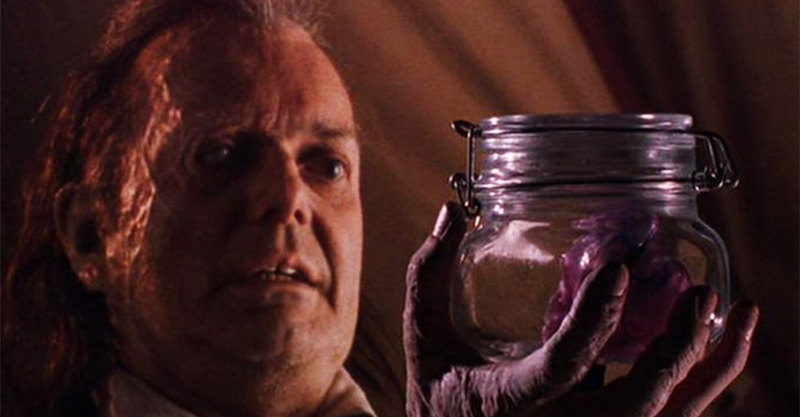The three-disc DVD set “Rags & Riches: The Mary Pickford Collection” presents three full-length features —“The Poor Little Rich Girl,” “The Hoodlum” and “Sparrows”— from the first true international star of film. In her day, Pickford was acknowledged as the greatest film actress of her time, and the most recognized face in the world– easily the biggest box-office draw in movies. Her only real competition for popularity and influence was Charlie Chaplin. Though Canadian-born, she became “America’s Sweetheart” and a cultural icon worthy of greater recognition today.
Not only was Pickford a luminous screen presence and an actress capable of a wide range of emotions, she was also the first female movie mogul, actively involved in the creation and production of her films, hiring the best directors, cameramen, set designers and writers for her projects. Famously a co-founder of United Artists, which created a new model of independent film production, she was a legendarily tough negotiator in a town built on tough negotiation, and for years was the highest paid performer in Hollywood. Her combination of on-screen power and off-screen savvy were years ahead of their time, making her a groundbreaking model for the contemporary actor-producer that is so commonplace now.
The film on Disc One, “The Poor Little Rich Girl” (1917) is, in many ways, a typical role for Pickford. As she did in a dozen films in her career, she plays a young girl—her skill, diminutive stature and youthful beauty made it possible for her to play adolescent roles into her early thirties. Gwendolyn is lonely and neglected by her wealthy status-and-money-obsessed parents, and struggles to make friends beyond the walls of her cloistered home.
Having never seen a Pickford film before, her acting is revelatory to me, full of striking emotional power. Pickford’s clear understanding of film acting, as separate from stage acting, makes her performances still relevant and true, and there is very little of the broad mugging and gesture that carried over from the stage. She shows her skill at both emotional moments and broader slapstick, and screenwriter and friend Frances Marion provides ample opportunity for Pickford to demonstrate the feistiness and energy she was so well known for.
Director Maurice Tourneur frames the action with exquisite care, often opening scenes with painterly tableaus that gradually open up with the actors’ movement. The art direction and set design are first-rate, and there is a marvelously crafted fantasy sequence in the last third where the creative visuals give the film a spontaneous energy, yet never overwhelm the emotional underpinnings.
“The Hoodlum” (1919) is a more workman-like production, possibly more typical of the standard programmers that filled the lower half of double bills throughout the early days of film. Pickford plays a spoiled rich young woman who follows her sociology professor father in a research trip to live in a poor section of New York City, against the wishes of here wealthy grandfather. The comedy is much broader, though occasionally funny, and the emotions much more sentimental. Pickford is still an engaging presence, and there is some interesting local color in the setting.
“Sparrows” (1926) is considered by some critics to be Pickford’s masterpiece, and this stunning restoration by the Library of Congress goes a long way towards proving that assertion. Pickford plays Mollie, an adolescent girl trapped with other children on a deep South “baby farm” with a cruel, abusive owner, Mr. Grimes. She attempts to mother and protect her fellow children, and eventually leads them on a harrowing escape across the swamp that surrounds their wretched home.
The Gothic setting of the film is realized with exquisite detail on screen, with an expansive set extending to pits of “quick sand” (a combination of sawdust, water and burnt cork) and real alligators. The influence of German Expressionist film is clear in the evocative photography and bleak subject matter, and director William Beaudine masterfully balances all the elements of taut suspense, comedic relief, emotional melodrama, and rich atmosphere.
Even a questionably extended ending doesn’t really harm the overall effect. Cinematography, editing and art direction are near perfect, and the supporting performances by the child actors, and the memorably monikered Gustav Von Seyffertitz as the monstrous Grimes, are all first rate. The musical score by Jeffrey Silverman is subtle and non-intrusive, maintaining the sense of lurking threat throughout without overstating it.
And Pickford’s performance is simply extraordinary. She infuses the memorably dark material with verve and energy, deep emotional commitment and tenderness, and a bracing physicality that heightens the truth of the moment. Special mention must be made of a truly moving scene where Mollie has a dream encounter with an historical figure, and wakens to a tragic reality. In the short sequence after she awakens, the play of expression and emotion over her face is masterful, finding a profound substance beneath what could have been mawkish sentimentality.
Video:
These are painstakingly restored versions of nitrate and dupe copy prints, so the video quality is varied. The inter-titles seem to have suffered the most, and there are sequences in “Poor Little Rich Girl” and “Hoodlum” with visible damage. But given the age of the original prints, the restoration is very well done, and the unavoidable occasional scratches and marks never interfere with the viewing. The original tinting has been reproduced, with especially good effect in “Poor Little Rich Girl” and “Sparrows.”
Audio:
The orchestral score in all three films in this set is admirably recorded and balanced, with clarity and attention to levels. The commentary tracks are well-centered. The set provides no other technical information about the audio track.
Extras:
Included with each feature is a modern-day “kid-friendly” intro and outro, where a group of middle-school-aged kids discover silent films with the help of their historian grandpa. These are informative, if a bit stiff, and kids who have never seen a silent film might them helpful in understanding some of the conventions and artistic standards of a vastly different era.
In the set-up menu, each feature also includes a spoken narration option, with a voice-over reading the title cards and written information shown on screen, and providing sporadic background information that might be helpful to younger viewers.
“Poor Little Rich Girl”:
- an informative and entertaining commentary track from film historian and Pickford biographer Scott Eyman
- amusingly weird home movie footage shot at Pickfair, the home Pickford shared with her husband Douglas Fairbanks
“Sparrows”:
- original theatrical trailer, with the typical breathless title cards
- a set of outtakes, discovered by archivists at the Library of Congress, of a replacement scene for a sequence involving Jesus in the finished release. Its purpose is not fully known, but was probably shot for international release in non-Christian countries. The “angel” photographic effect is very well done.
- The Mary Louise Miller Story: an interesting biographical short of the curly-headed baby actress featured in “Sparrows,” including a screen test and an interview with Miller’s daughter
- a commentary track by silent film historians Jeffrey Vance and Tony Maietta, which manages to avoid redundancy with the other commentaries and present interesting background on the film and the other actors in the film
“The Hoodlum”:
- “Ramona: A Story of the White Man’s injustice to the Indian”: a 17-minute short film shot in 1910, about the romance between a Spanish girl, Ramona (Pickford) and an American Indian man, improbably named Alessandro. The comparatively stiff technique makes for interesting comparisons to the later, more developed work in the other features in the set.
Parting thoughts:
The three features making up “Rags & Riches: The Mary Pickford Collection” are a vastly entertaining and emotionally engaging introduction to the silent films of one of cinema’s greatest and most influential stars. “Sparrows” and “The Poor Little Rich Girl” are critical viewing for any student of film history, and anyone interested in the development of modern screen vocabulary and acting style. The “kid-friendly” elements are an honorable attempt at broadening the audience for silent film.


